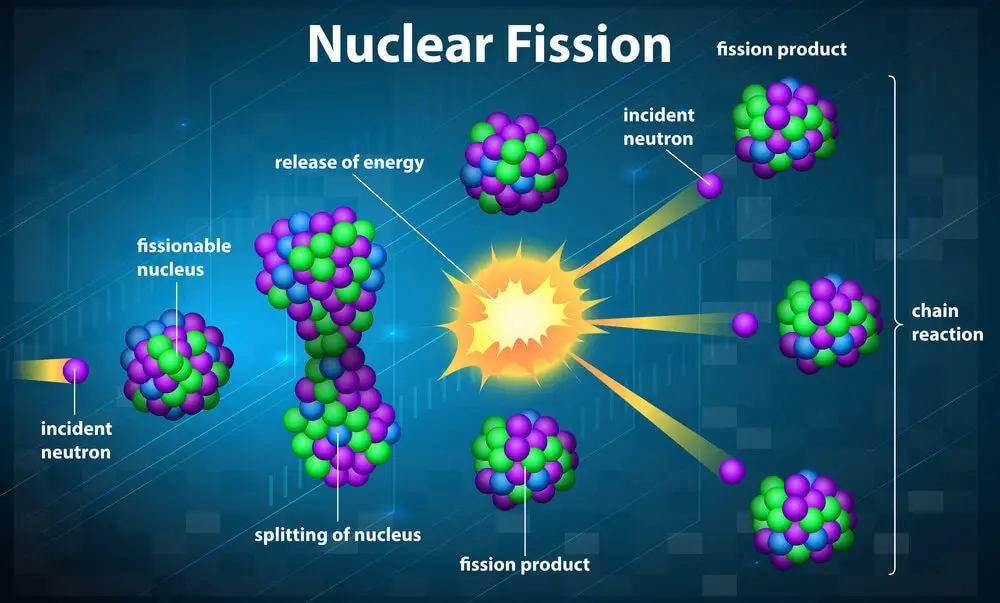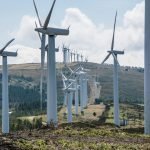In nuclear fission, heavy nucleus (atoms) are split apart into smaller pieces, thus releasing energy in the process.
Nuclear fission is 1000 times more efficient as compared to traditional fossil fuels – at producing energy.
The question as to whether nuclear fission is renewable or not is a subject of significant debate.
And if so, it could be an incredible source of energy.
Our post will narrow down everything about nuclear fission and how it impacts our environment and the future.
Let’s dive in!
Why is Nuclear Fission Considered Renewable?
There’s a release of nuclear energy through the fission process of unstable atoms, which is clean and efficient than fossil fuels.
Most supporters argue that nuclear fission used in nuclear power plants releases low carbon emissions.
And remember that this is a significant characteristic associated with renewables.
Is nuclear fission in reactors renewable?
The answer can be yes or no.
Conventional fission in reactors is renewable to some extent, as nuclear power plants use it to create clean power.
However, these power plants use Uranium during the nuclear process.
Unlike wind energy and solar power, Uranium is on the list of non-renewable resources.
Is nuclear fission a renewable energy source?
Not 100% a renewable process.
Although nuclear fission can make electricity, it uses Uranium which is non-renewable.
How Clean And Sustainable Is Nuclear Fission? (Reasons)
Nuclear fission is responsible for the release of clean nuclear energy.
Most people use wind turbines and solar panels, but nuclear is among the largest sources of low-carbon energy worldwide.
But why is it regarded as clean?
- Nucleus is a zero-emission source of energy. Through fission, uranium atoms split into small pieces to produce energy. The heat released by these nuclear plants produces electricity without emitting harmful byproducts.
- Land footprint is small. Nuclear produces a massive amount of clean power. The energy generates more electricity on less land as compared to our sources. According to NEI, wind farms and solar plants require 360 and 75 times more land area, respectively.
- It produces minimal waste. One notable thing is that nuclear energy is very dense. So, it’s a thousand times greater than other resources. With this, we use a smaller amount of nuclear fuel than you may think.
In 2019, the USA steered clear of nearly 470 million metric tons of CO2 emissions as they adopted nuclear energy, which comes from the fission process.
This eliminates poor air quality that can contribute to cardiovascular disease and lung cancer.
Air pollution can also result in acid rain and smog.
Again, if you use solar panels, you’ll need one million units to achieve the same megabits as a typical nuclear reactor.
How Does Nuclear fission Affect the Environment?
One major drawback is that nuclear fission can impact the environment negatively.
And for this reason, some countries do oppose nuclear energy.
When the nuclear fission process occurs, the byproducts produced come in the form of an unstable atom called radioactive material.
If you dispose of these radioactive materials in the open, it will harm the planet.
Even worse, radioactive material is toxic for both human beings and animals.
It can cause radiation poisoning, lead to cancer, cause burns and bone decay.
Another byproduct is radioactive waste.
If this dust sticks in worker’s clothes, it will be very hazardous.
However, if companies follow government regulations to dispose of the waste, we wouldn’t have any controversial issues.
Is Nuclear Fission Dangerous?
In one way or the other, nuclear fission isn’t safe all the time.
There are some problems associated with it.
Although it provides more than 30% of electricity in the US, the use of nuclear isn’t surrounded by benefits only, but there are dangers of cancer:
- Radioactive waste is dangerous to human and animals
- Possible nuclear accident like burns
- Radioactive material is toxic
- People can weaponize the proliferation of material
- The use of Uranium destroys the environment
For these reasons, anti-nuclear people will prefer wind and solar energy as alternatives.
The two are 100 percent renewable energy that could address energy needs.
Is Nuclear Fission Available At All Times
Not at all times. Keep in mind that nuclear power plants use Uranium as the common fuel.
The biggest problem is that the suitable type of Uranium to use is rarely accessible.
This may disrupt the consistency of the fission process. Here are the two main reasons:
- Uranium is finite, yet nuclear fission requires Uranium.
- Nuclear isn’t highly renewable – only under certain circumstances.
Advantages and Disadvantages of Nuclear fission
Just like any other thing, nuclear fission comes with some significant advantages and disadvantages to talk about.
Advantages
- Nuclear emits low carbon. Unlike coal or natural gas, nuclear power produces few emissions. It’s therefore fairly clean as it won’t damage the environment to high levels.
- Nuclear runs 24/7. It can be harnessed round the clock up to 1-2 years at a time. It doesn’t rely on sunlight or wind. Consumers will enjoy nonstop power without any downtime.
- Efficient source of energy. The fact that fission is non-renewable doesn’t make it inefficient. It’s energy-efficient, both in cost and output. Companies are generating electricity at a lower financial cost than fossil fuels.
Disadvantages
- Nuclear waste. It’s, however, a complicated source of power. It’s difficult to dispose of nuclear waste as we would want. With such highly toxic byproducts, the environment will be at high risk.
- Risk to workers. Of course, radioactive dust is dangerous. The whole process poses threats to workers and staff around it. It will boil down to health problems like cancer, breathing difficulties, among others.
- Building and infrastructure of nuclear reactors require money, skills, and advanced technology. Only developed countries can manage nuclear power plants.
How Safe Is Nuclear Fission?
As seen, there are only a few accidents in this case, but many people do worry about high toxic waste produced.
The waste is unsafe for the air, atmosphere, and human health.
The chances are that the storage facility could be leaking an amount of contamination to water and soil around it.
This can harm flora and fauna over time.
Why is Nuclear Energy via Fission Not Considered a Renewable Resource?
Because nuclear energy via the fission process requires fuel, which in most cases is Uranium.
Uranium is a non-renewable element.
Setting up solar panels or wind turbines could be costly but worth it if we want to promote a healthy environment.
The Future of Nuclear Energy
We’ll agree that nuclear energy has a lot of advantages.
And as we carry on, it will continue to be an essential part of electricity generation.
Probably it won’t be a true renewable.
Is nuclear fission possible?
Only time will tell. Altogether, solar power and wind power are pretty significant.
Conclusion
It’s no secret that using renewables whenever possible is our dream.
And our norm should be ‘going green.’
If the whole idea is to pursue an eco-friendly environment, then making an informed decision is a must-do thing.
Nuclear energy via fission produces clean power, but it’s renewable energy.
The vast majority feel that we should be backing off solar and wind energy.



